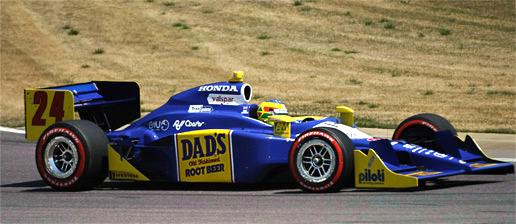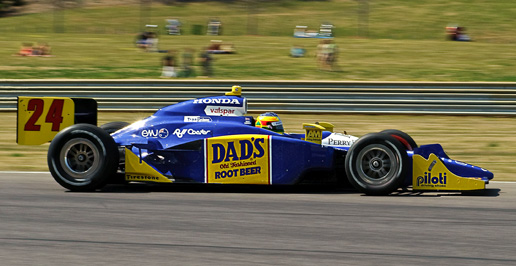I wanted to run this week’s episode of D-Town TV (The weekly show for all DSLR users—it’s not just a Nikon only show anymore), here because I wanted to add something that I would have liked to have been included in the show, and also because it’s so timely with the Indy shoot that I wound up doing earlier this week.
In the first part of the show, I talk about a Panning technique to show motion in sports photography, and I got a lot of really positive feedback about the piece, but I wish I had gotten some examples to the video crew before the show aired (totally my fault, by the way), so I’m going to show them here instead:
Above: Here’s a throw-away shot from last year. With a fast shutter speed, the car is sharp, but it’s also frozen, so it kind of looks like the car is parked on the track rather than speeding through it at over 100 mph. This was taken with a shutter speed of a 1/6400 of a second.
Above: Look at the movement and sense of speed that’s created by using a slower shutter speed (1/320 of a second in this case, or less—down to 1/100 of a second) and panning using the technique I outlined in the episode above. You see wheel spin, and motion blur in the background (not added in Photoshop), and yet the car (well, most of it) is sharp (again, another throw-away shot). However, the whole image tells you the car is moving fast.
Anyway, watch the video above and this will all make a lot more sense.
NOTE: Also in this episode, we have another of Larry Becker’s “Cheap Shots,” some tips from Canon Explorer of Light Rick Sammon, a set of beginner tips from Matt, and some other stuff, so if you’ve got a minute, check it out.





Great stuff..yet to watch the latest episode of D-Town TV, but I imagine this ain’t easy right? For the high shutter speed shots necessary to stop the car in motion, I’m guessing a f/3.5 lens unless on a very sunny day might be too slow right?
I *love* Todd Owyoung’s concert photography. Can you (Scott) get him to do a Wednesday Guest Blog? Please?
I think you have the wrong episode. This episode isn’t about panning!
Hi Mattias:
I just checked it again (you had me worried there for a minute), but it’s the first thing I talk about in the episode above. Give it another look. :)
-Scott
I don’t know what happened but it was another episode the first time I watched it. I don’t know why but maybe it was something with my browser that messed it up I have no idea but it seems weird that I got the first episode before but it works perfect now. I haven’t cleared by cache or anything.
Anyway sorry for making you worry in wane.
I looked on it now and the one that shows here now is episode 35 but when i looked the first time it was episode 36.
have you tried an ND filter to give you more sunshine latitude for slower shutterspeeds ?
Hi Lyle:
I haven’t, because I don’t have a ND large enough for my long glass. My NDs are for my 50mm f/1.4. I got lucky that during some of the race it was overcast. There’s definitely a trade off, because I’d like to shooting at f/4 or f/2.8 to help the cars stand out from the background, but at slower shutter speeds, I wind up at f/11 and f/16 or higher.
-Scott
Not sure of the effect on autofocus speed, but you could handle many lenses with an oversized Lee filter setup… I don’t have venue to try auto shooting of this nature, but it might be an option. :)
I wish these vendors could provide more low ISO capability, but I know they have a massive tradeoff matrix in designing the sensor chips to begin with and imagine the high iso wins almost all the time. lol It’s crazy cool the high speeds an low noise, even on my d700 !!!
Hey Scott,
Great post with more really useful tips; thanks for sharing and hey no worries…the ‘word’ is being spread :)
All the best to you,
Glyn
I love the fact that you’re sportin’ some fine Zildjian wear on this episode.
Zildjian and Tama is what I use (can’t afford DW’s).
Hey folks! I have watched almost all the episodes from last year and I was very glad to find that you continue to make your great show. I am using an old but very handy nikon D70, have a problem though. I want to shoot basketball games in low light conditions, as you know D70 performs not so good on high ISO. How can I improve my pics using these lenses (N18-70, 50- 1.8, N135-2.0 DC) and no flash. Greetings from Poland. Tomasz
Hi Tomasz,
I learned from experience that trying to shoot basketball under poor lighting conditions with slow lenses is a recipe for frustration. Your best bet is to crank the ISO as high as possible, use you 50 1.8 and sit just right or left of the basket. You are better off getting noisy shots than blurred shots. You can always reduce the noise with software, but a blurred image is pretty much a useless image.
I started shooting college/university basketball last fall and by this spring I had two of the final 8 schools hire me to shoot their games in the national championships. One of the two schools, the University of Saskatchewan Huskies, actually won the national title which, as their official tournament photographer, was very exciting for me as well.
Good luck!
Trev J.
Hi Trevor! Thanks for the tip I will follow your edvice. Good Luck to you as well!
Tomasz
This was a very interesting show for me, at least the beginning. I tend to pan at a LOT slower shutter speeds when I’m at the track (just as an amateur, my boyfriend does a lot of driving in races, and what else am I going to do at the track?). Yes, I have more throwaway shots when I’m shooting at 1/50s, but I think you get better separation from the background simply because the panning blurs it for you. And yeah, I do end up at f/22 to get the longer shutter speed, but it doesn’t bother me that much.
Here’s an example from a recent LeMons race: http://quotidian-photography.blogspot.com/2010/03/panning.html
Anyway, love to hear your thoughts on this, Scott.
Thank you, it makes me feel better knowing that I am not the only one who forgets to check his ISO when I start shooting.
What I would like to know is if anyone know of a good floor seat for shooting basket ball? Maybe the Rockstars at D-Town would do a segment????? (;>)
I used to sit on a fabric covered child’s swimming inflatable inner-tube, half inflated. Worked great. Another guy I knew got a swimmer’s kickboard that was spongy foam and covered with a slick plastic surface. it was the right size and no inflation required. Maybe that give you some ideas.
First of all, I really appreciate D-Town TV. I’ve learned a lot already and I always look forward to new episodes being released. I notice that whenever you mention shooting at the lowest possible ISO, it seems 200 is always mentioned. Does that mean you should use 200 rather than 100 ISO as the lowest ISO, even if the camera goes to 100 ISO, or are the two really just interchangeable because of the low noise capabilities of today’s DSLRs?
I think is because Nikon D3’s lowest ISO is at 200 nor 100 . (Just like my D50 =P)
yes I will tune into you guys now that you work with canon.